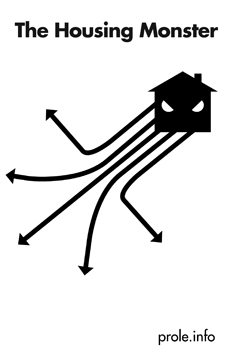The Housing Monster

Every Town is a Company Town
The Housing Monster
By prole.info
2012, Pm Press,
165 pages, $14.95
This small book is crammed full of powerful critiques of the financing, production, and consumption of housing under capitalism. Similar to other publications authored by prole.info, the text is accompanied on every page with striking black-and-white drawings that flesh out the authors’ arguments.
The Housing Monster is at least partially an effort to make key concepts of Marxist economics more accessible to contemporary readers. We are led through an analysis of the labor theory of value, capital accumulation, and crisis through examples such as the exploitation of wage labor in the construction industry and the economic booms and busts of the housing market.
The roles of different kinds of capitalists (contractors, developers, landlords, and bankers) are discussed in detail. While sharing a common interest in making the maximum profit off of either exploiting or ripping off the working class, these different kinds of capitalists are also frequently at odds with each other. Employers might support demands for affordable housing—not because they have genuine concern for their employees’ welfare, but because lower rents allow bosses to pay lower wages.
The working class is also shaped by various forms of difference and riven by internal contradictions. Skilled workers who are homeowners may believe that they have more in common with their boss than with workers who experience more precarious employment and housing situations. People displaced from their neighborhood due to super-gentrification may find themselves actually becoming gentrifiers in another neighborhood.
However, there are major problems with the book’s discussion of identity and difference amongst the working class. The U.S. working class has always existed in relation to a specifically white supremacist (and patriarchal, heterosexist, nationalist, and ableist) capitalism. Unfortunately, the book tends to treat these interlocking systems of oppression just as differences hindering the ability of the working class to unite and struggle against their “real (capitalist) enemy.”
A contrasting organizing strategy is examined in Michael Staudenmaier’s “Truth and Revolution,” which details the work of the Sojourner Truth Organization (STO) in the 1970s. The STO was a predominantly white revolutionary organization that focused on building militant workers’ committees, while striving to challenge racism and white privilege among white workers. For the STO, such antiracist organizing was intended to combat white supremacy everywhere, which they viewed as a necessary part of any effort to build a multiracial anti-capitalist movement.
GREENLINING
The book would have also benefited from more attention to the ways that racism and capitalism have constrained housing opportunities for people of color. As one example, when the federal government began intervening in the home mortgage market during the Depression, it exacerbated racial inequalities through the greenlining of mortgage guarantees for whites while redlin- ing communities of color. New homes that were only available to white purchasers reinforced what George Lipsitz has termed the “possessive investment in whiteness,” as racial exclusion was utilized to increase property values.
I also took issue with the authors’ treatment of patriarchy, sexism, and gender. Sections of the book do discuss how contractors benefit from macho culture among construction workers by getting them to take more risks, as well as some of the ways in which remnants of pre-capitalist patriarchal structures interact with newer forms of capitalist patriarchy in the domestic and public spheres. But these discussions are brief and lack the insight found in the works of autonomous Marxist feminists such as Silvia Federici.
The book does strongly make the case that capitalism will never tolerate housing reforms that truly threaten capital accumulation. In chapters on public housing, rent control, collective living, and unions, the authors acknowledge that working-class movements have, in certain times and places, been able to achieve improvements in their standards of living. But so long as the economy is structured around the principle of surplus value extraction by capitalists, the interests of the working class will continue to be undermined.
Despite my strong differences in opinion with portions of the book’s analysis, I would recommend it to anyone interested in housing issues. It is a valuable contribution to current debates on revolutionary alternatives to the unending housing crisis that is a permanent feature of life under capitalism.
